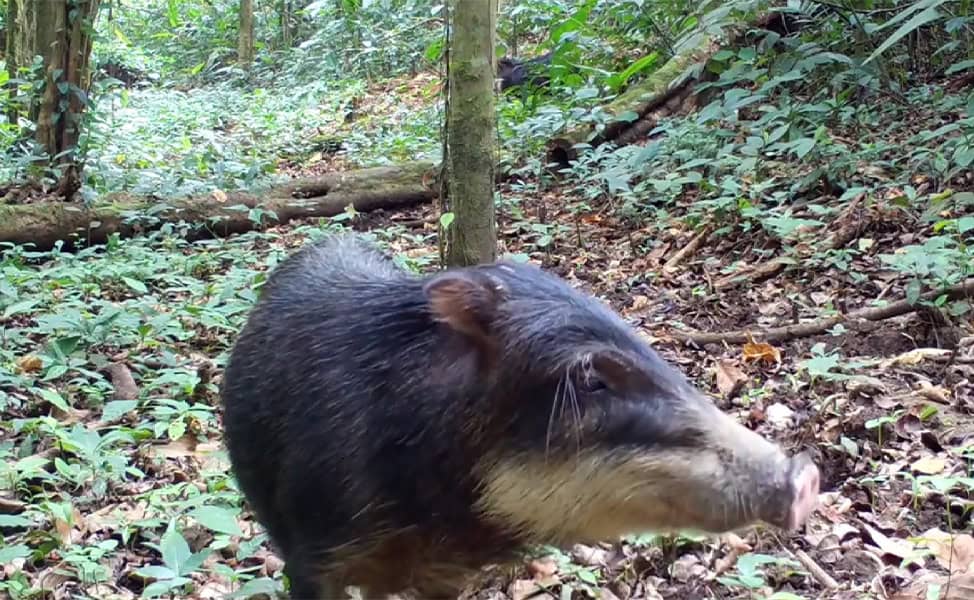Today we meet the white-lipped peccary, a large animal that travels in large groups that has disappeared from a large part of its historical range. The white-lipped peccary (Tayassu pecari) is most frequently known as the chancho de monte in Tico Spanish which translates to wild pig in English.
I know one guy who exclusively refers to them as cariblancos, which is always terribly confusing to me because that’s the common name for white-faced monkeys, but makes sense because these peccaries indeed have white faces.
I just looked it up and the internet confirms that cariblanco is used, but if you’re speaking Spanish and talking about white-lipped peccaries, do everyone a favor and say chancho de monte.
White-lipped peccaries are one of two species of peccary in Costa Rica, with the other being collared peccaries. One of the ways they differ from each other is in body size. White-lipped peccaries are significantly larger, coming in at 30 kilograms or 66 pounds.
Both species have the same general coloration, a base color of blackish brown with a white highlight. The collared peccary’s white comes in the form of a white collar around their neck. The white-lipped peccary has a white patch on its face stretching from its lower lip up into its cheeks.
Historically, the white-lipped peccary was found throughout the varied habitats of Costa Rica, but, like almost every other country within its range, they have been extirpated from much of that territory. In Costa Rica, this large peccary is absent from 89% of the habitats that it used to call home.
Today, it’s only found in a few places including the area around Tortuguero, forests around Rincón de la Vieja National Park, in the Talamanca Mountain range, and, most famously, in Corcovado National Park in the Osa Peninsula.
Two of the major reasons for their population decline in Costa Rica are related to human activity. The first is hunting. These large peccaries provide a lot of meat for hunters and their behavior while being hunted doesn’t do them any favors. When white-lipped peccaries are attacked by a predator they often stand their ground instead of fleeing, this allows hunters to take numerous members of the herd at once.
The second thing we humans do that doesn’t agree with white-lipped peccaries is habitat fragmentation. White-lipped peccaries travel in enormous groups of 50 to several hundred individuals. It takes a huge amount of fruit, seeds, vegetation, and invertebrates to feed that many large peccaries, so they need vast areas of wilderness to travel around in to locate food.
When the wild areas are chopped up, these huge herds have a hard time finding enough food and are more vulnerable to hunting at the same time. Being such a rare creature in the forests of Costa Rica I’ve had very few occasions to record them with my camera traps.
When I first started wildlife monitoring about five years ago, I recorded a few videos of white-lipped peccaries on private farms near Rincón de la Vieja National Park. I was happy enough to record them at the time, but I wasn’t really aware of how special it was.
After years of coming up empty, my luck changed last month. I was at the end of a day reviewing camera traps in Alajuela on the northeast side of Rincón de la Vieja. It was raining and I had one last camera to review, which was a kilometer and half hike away.
My old man knee was acting up and I was seriously considering skipping the camera, which hadn’t recorded anything interesting for several months. I decided to suck it up and make the hike and I’m glad I did. The camera had recorded three white-lipped peccary clips, including one where a decent-sized herd can be seen swimming across a small river. I couldn’t have been happier to see them.
I’ve combined my beginner’s luck clips and my brand-new clips in the video below. Enjoy!
About the Author
Vincent Losasso, founder of Guanacaste Wildlife Monitoring, is a biologist who works with camera traps throughout Costa Rica.






